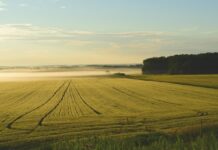Why in the world would you put animals out to graze on annual forages grown between cash grain crops?
Back in December, this column began to answer that question. Curt Stivison and Stan Smith described the tremendous savings in feed costs obtained with cows grazing oats planted in August after winter wheat on the Wolfinger family farm.
That is just the beginning of the story, as we continue to explore this alternative with producers in the region.
Combination benefits. There are many benefits to combining pasture-based livestock production and cash grain production on the same farm.
Research has shown that diversifying production in this way can increase profits. In addition, it reduces the year-to-year variation in returns, especially when compared with cash grain only systems (especially if government deficiency payments are not considered).
So the two enterprises, cash grain and pasture-based livestock production, can moderate the yearly oscillations in income.
Combining livestock grazing with cash grain production provides more diverse crop rotations. This is sorely needed in our farm landscape.
Annual pastures sown between consecutive grain crops provide for year-round vegetative cover, protecting the soil.
Grazing livestock efficiently recycle nutrients, with good management. In fact, animal manure produced on good quality winter pasture represents a high quality organic material that is high in nutrient concentration.
Animal grazing of winter forages may provide more readily available nutrients to the subsequent crop than non-grazed cover crops or crop residues.
Negatives? But don’t animals compact the soil? Surely this will reduce yields of the next grain crop!
This is indeed a fair question, and those interested in grain production become very concerned about this. Research has some answers.
Animals do indeed cause some soil compaction. The degree of compaction depends on many interacting factors that I won’t go into now. But research shows that, with good grazing management, yields of the next grain crop can be maintained at levels similar to non-grazed areas.
One study measured corn yield areas of high animal traffic near water and mineral supplements. The corn yield in the high traffic areas was the same as in lower traffic areas and non-grazed areas.
In well-managed integrated systems, compaction caused by grazing is alleviated by biological activity. The compaction tends to be fairly shallow. Root growth of the annual pasture and soil organisms help counteract it.
Animal compaction can be reduced by maintenance of sufficient pasture cover during grazing (not grazing real short), and removing animals when soil conditions are very wet.
The following grain crop provides a break from hoof traffic, and root growth of the summer grain crop also helps alleviate the previous compaction effect.
Keeping soil structure. No-tillage is an important practice in these systems, because soil structure is maintained, providing for better support of grazing animals.
In southern Brazil, many farmers are adopting winter grazing between summer grain crops. They are achieving remarkable increases in efficiency on the same land base through these integrated systems, not to mention the biological benefits.
You may think that farmers have an easier time of winter grazing in southern Brazil compared to our situation. But they too have challenges with winter pasture production.
First, there usually is a dry spell in the fall that limits pasture establishment and growth in southern Brazil. Then the cold weather and frosts set in. They don’t get the snow, but pasture growth is slow for much of the period between fall grain harvest and spring planting.
The expected winter pasture production in southern Brazil, with good management and nitrogen fertilizer, is 7,000-9,000 pounds of dry matter per acre.
We can come very close to achieving those production levels with winter annual pastures in Ohio! What are we waiting for?
A good fit. What I have discussed here does not fit everyone’s situation. But for some of you, the opportunity is knocking on the door.
Now is the time to start planning for how to use those idle grain crop acres for autumn to spring grazing.
That, along with stockpiled perennial pastures can pay big dividends. Enjoy a wonderful summer grazing season, but don’t put off planning for the cold months ahead.
(The author is an associate professor in the Department of Horticulture and Crop Science at Ohio State University. Questions and comments can be sent in care of Farm and Dairy, P.O. Box 38, Salem, OH 44460.)












